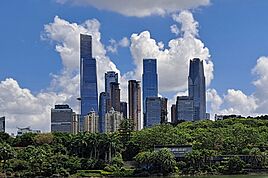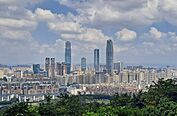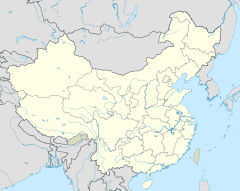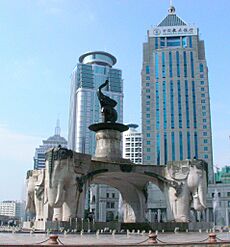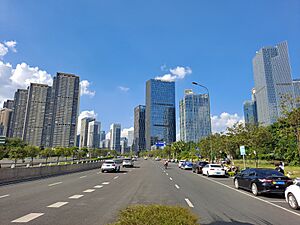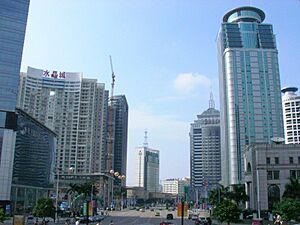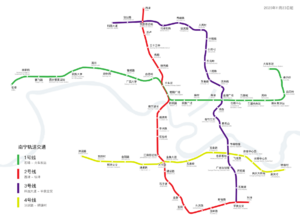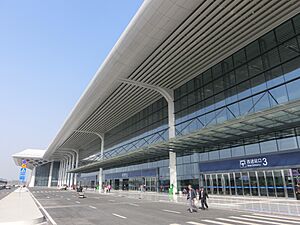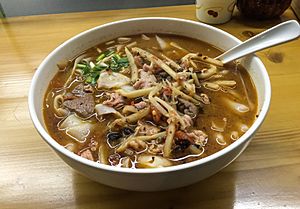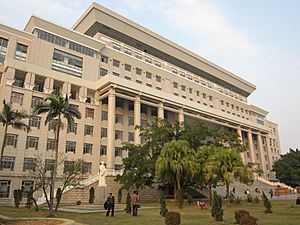Nanning facts for kids
Quick facts for kids
Nanning
南宁市 · Namzningz Si
|
|
|---|---|
|
Prefecture-level city
|
|
|
Qingxiu District skyline
NICEC
Qingxiu Mountain
Longxiang Pagoda
View from Qingxiu Mountain
|
|

Location of Nanning City jurisdiction in Guangxi
|
|
| Country | China |
| Region | Guangxi |
| Municipal seat | Qingxiu District |
| Government | |
| • Type | Prefecture-level city |
| • Body | Nanning Municipal People's Congress |
| Area | |
| • Prefecture-level city | 22,189 km2 (8,567 sq mi) |
| • Urban | 6,559 km2 (2,532 sq mi) |
| • Metro | 5,264 km2 (2,032 sq mi) |
| Population
(2020 census)
|
|
| • Prefecture-level city | 8,741,584 |
| • Density | 393.960/km2 (1,020.352/sq mi) |
| • Urban | 5,977,185 |
| • Urban density | 911.30/km2 (2,360.24/sq mi) |
| • Metro | 5,293,359 |
| • Metro density | 1,005.58/km2 (2,604.43/sq mi) |
| GDP | |
| • Prefecture-level city | CN¥ 512.1 billion US$ 79.4 billion |
| • Per capita | CN¥ 58,241 US$ 9,028 |
| Time zone | UTC+8 (China Standard) |
| Postal code |
530000
|
| Area code(s) | 0771 |
| ISO 3166 code | CN-GX-01 |
| License plate prefixes | 桂A |
| Nanning | |||||||||||||||||||||||||||
|---|---|---|---|---|---|---|---|---|---|---|---|---|---|---|---|---|---|---|---|---|---|---|---|---|---|---|---|
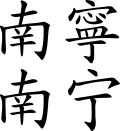
"Nánníng" in Traditional (top) and Simplified (bottom) Chinese characters
|
|||||||||||||||||||||||||||
| Chinese name | |||||||||||||||||||||||||||
| Simplified Chinese | 南宁 | ||||||||||||||||||||||||||
| Traditional Chinese | 南寧 | ||||||||||||||||||||||||||
| Hanyu Pinyin | Nánníng | ||||||||||||||||||||||||||
| Literal meaning | "Southern tranquility" | ||||||||||||||||||||||||||
|
|||||||||||||||||||||||||||
| Zhuang name | |||||||||||||||||||||||||||
| Zhuang | Namzningz | ||||||||||||||||||||||||||
| 1957 orthography | Namƨniŋƨ | ||||||||||||||||||||||||||
Nanning is the capital city of the Guangxi Zhuang Autonomous Region in southern China. It's often called the "Green City" because it has so many lush, green plants and trees. Nanning is located in a hilly area in the south of Guangxi. It has a warm, humid climate with lots of rain during certain times of the year.
Since 1949, Nanning has grown a lot. It used to be mainly a trading and government center. Today, it's the main hub for business, money, and culture in Guangxi. It's also a key place for training people from the Zhuang ethnic group. The People's Park is right in the middle of the city. Nanning also helps connect China with countries in Southeast Asia.
The city is home to several important universities. These include Guangxi University and Guangxi Medical University.
Contents
- Nanning's Long History
- How Nanning is Organized
- Nanning's Cityscape
- Nanning's Economy
- Getting Around Nanning
- Plants and Animals in Nanning
- Nanning's Geography and Climate
- Nanning's Sister Cities
- People of Nanning
- Nanning's Culture and Education
- Fun Places to Visit in Nanning
- Colleges and Universities in Nanning
- Famous People from Nanning
- See also
Nanning's Long History
Nanning is a very old city with a rich past. It was once home to the Baiyue ethnic groups.
Early History of Nanning
In the year 318 AD, during the Eastern Jin Dynasty, a place called Jinxing County was set up here. This was the start of Nanning's official city system, which is now 1700 years old! Later, in 632 AD, during the Tang dynasty, the city was renamed Yong Prefecture (Yongzhou). This is why Nanning is sometimes called Yong for short.
In 1076, during the Lý–Song War, Yongshou was attacked by Lý forces. The city fought for over 40 days but eventually fell. The city was destroyed, and many people were killed.
In 1318, during the Yuan dynasty, Yongzhou was renamed Nanning. This name means "Pacified South." Nanning was famous for trade even back then. It had business offices from other parts of China since the Song dynasty. During the Ming dynasty, Nanning became an important economic center. It was even called "Little Nanjing" because of its trade.
Nanning in Modern Times
On December 4, 1949, the Communist Party took control of Nanning. In January 1950, Nanning became a city. It was chosen as the capital of Guangxi on February 8 of the same year. In March 1958, the Guangxi Zhuang Autonomous Region was created, and Nanning remained its capital.
Since 2004, Nanning has hosted the yearly China–ASEAN Expo. This event helps connect China with countries in Southeast Asia. In 2006, the city also hosted the World Robotics Olympiad.
How Nanning is Organized
Nanning is divided into different areas for local government. It has 7 districts, 1 county-level city, and 4 counties. It also has 6 special development zones.
| Map | |||||||||
|---|---|---|---|---|---|---|---|---|---|
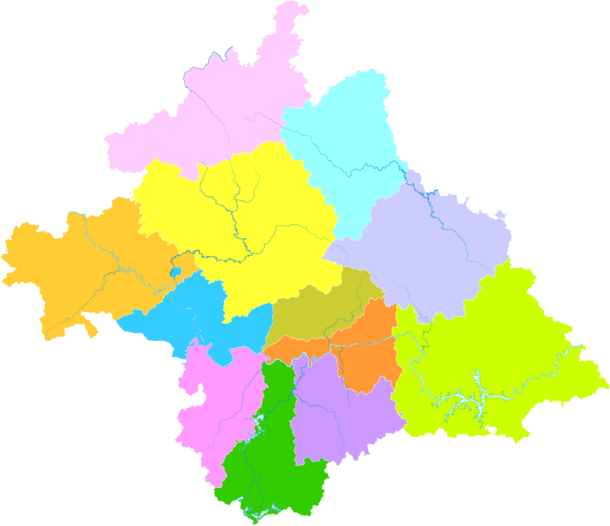
Xingning
Qingxiu
Jiangnan
Xixiangtang
Liangqing
Yongning
Wuming
Long'an
County Mashan
County Shanglin
County Binyang
County Hengzhou
(city) |
|||||||||
| Name | Chinese | Hanyu Pinyin | Zhuang | Population (2010) | Area (km2) | Density (/km2) | |||
| City proper | |||||||||
| Xingning District | 兴宁区 | Xīngníng Qū | Singhningz Gih | 398,789 | 722.68 | 551.82 | |||
| Qingxiu District | 青秀区 | Qīngxiù Qū | Cinghsiu Gih | 709,721 | 865.27 | 820.23 | |||
| Jiangnan District | 江南区 | Jiāngnán Qū | Gyanghnanz Gih | 567,999 | 1,183.26 | 480.03 | |||
| Xixiangtang District | 西乡塘区 | Xīxiāngtáng Qū | Sihsienghdangz Gih | 1,153,305 | 1,076.00 | 1071.84 | |||
| Liangqing District | 良庆区 | Liángqìng Qū | Liengzcing Gih | 344,768 | 1,368.88 | 251.86 | |||
| Yongning District | 邕宁区 | Yōngníng Qū | Yunghningz Gih | 259,721 | 1,230.73 | 211.03 | |||
| Suburban and satellite city | |||||||||
| Wuming District | 武鸣区 | Wǔmíng Qū | Vujmingz Gih | 544,478 | 3,388.91 | 160.66 | |||
| Hengzhou City | 横州市 | Héngzhōu Shì | Hwngzcouh Si | 863,001 | 3,448.06 | 250.29 | |||
| Rural | |||||||||
| Long'an County | 隆安县 | Lóng'ān Xiàn | Lungzanh Yen | 300,215 | 2,305.59 | 130.21 | |||
| Mashan County | 马山县 | Mǎshān Xiàn | Majsanh Yen | 390,900 | 2,340.76 | 167.00 | |||
| Shanglin County | 上林县 | Shànglín Xiàn | Sanglinz Yen | 343,590 | 1,871.00 | 183.64 | |||
| Binyang County | 宾阳县 | Bīnyáng Xiàn | Binhyangz Yen | 782,255 | 2,298.17 | 340.38 | |||
| Total | 6,658,742 | 22,099.31 | 301.30 | ||||||
Nanning's Cityscape
Nanning has some very tall buildings. The Diwang International Commerce Center is 276 meters tall. It's the tallest building in Guangxi and in southwestern China (outside of Chongqing). The World Trade Commerce City is the second tallest at 218 meters. The city has seven buildings that are taller than 100 meters, either built or being built.
Nanning is famous for being one of China's "greenest" cities. It has many parks with beautiful tropical plants. The city's downtown area is changing quickly, becoming a major center in China. The government has also started a plan to make the city even cleaner and more beautiful.
Nanning's Economy
In 2015, Nanning's economy was worth 341 billion Chinese Yuan (RMB). This means the average income per person was about $7,844 US dollars. The city is rich in natural resources like gold, iron, manganese, and coal. About one-third of all the different types of minerals found in China can be found in Nanning.
Getting Around Nanning
Nanning has a modern transportation system to help people travel.
Metro System
The Nanning Metro system, also called Nanning Rail Transit (NNRT), will have nine lines when finished.
- Line 1 opened in June 2016. It connects the east and west sides of Nanning.
- Line 2 started running in December 2017.
- Line 3 opened in 2019, and Line 4 in 2020.
Air Travel
- Nanning Wuxu International Airport is the main airport for the city.
Train Travel
Nanning has two main train stations: Nanning railway station and Nanning East railway station. The East station is newer and mostly handles high-speed trains. A third station, Nanning North railway station, is planned to open in 2023. Nanning is an important railway hub, connecting to several major lines. There are also plans for a high-speed railway to Pingxiang, near the Vietnamese border. This will help connect China with Southeast Asian countries.
Highways
Many national highways and expressways pass through Nanning. These include:
- China National Highway 210
- China National Highway 322
- China National Highway 324
- China National Highway 325
- G72 Quanzhou–Nanning Expressway
- G7201 Nanning Ring Expressway
- G7211 Nanning–Youyiguan Expressway
- G75 Lanzhou–Haikou Expressway
- G80 Guangzhou–Kunming Expressway
Plants and Animals in Nanning
Nanning's warm climate means it has a huge variety of plants and animals. There are over 3,000 different types of plants! The city's official flower is the Jaba flower, which is an evergreen shrub. The city's official tree is the almond tree. These trees are used all over the city to make it green and beautiful.
Nanning's Geography and Climate
Nanning is in the southern part of the Guangxi Zhuang Autonomous Region. It's about 160 kilometers (100 miles) from the border with Vietnam. The city covers an area of about 22,293 square kilometers (8,607 square miles). Nanning is in a hilly area, with elevations ranging from 70 to 500 meters (230 to 1,640 feet) above sea level. Qingxiu Mountain is a prominent feature in the southern part of the city.
Nanning has a warm and humid climate. The average temperature for the whole year is 22.3°C (72.1°F). Summers are hot and humid, with July being the hottest month at an average of 28.5°C (83.3°F). Winters are mild and a bit damp, with January being the coolest month at 13.3°C (55.9°F). It rains a lot from February to August. Snowfall is very rare in Nanning; it has only snowed once since 1900, in December 1975, but it didn't stick to the ground.
| Climate data for Nanning (Yongning District) (1991–2020 normals, extremes 1951–2010) | |||||||||||||
|---|---|---|---|---|---|---|---|---|---|---|---|---|---|
| Month | Jan | Feb | Mar | Apr | May | Jun | Jul | Aug | Sep | Oct | Nov | Dec | Year |
| Record high °C (°F) | 32.6 (90.7) |
36.2 (97.2) |
35.5 (95.9) |
38.3 (100.9) |
40.4 (104.7) |
37.9 (100.2) |
39.0 (102.2) |
39.1 (102.4) |
38.2 (100.8) |
35.2 (95.4) |
33.7 (92.7) |
30.5 (86.9) |
40.4 (104.7) |
| Mean daily maximum °C (°F) | 17.3 (63.1) |
19.2 (66.6) |
21.8 (71.2) |
27.2 (81.0) |
30.9 (87.6) |
32.3 (90.1) |
32.9 (91.2) |
33.1 (91.6) |
32.1 (89.8) |
29.1 (84.4) |
24.9 (76.8) |
20.0 (68.0) |
26.7 (80.1) |
| Daily mean °C (°F) | 13.3 (55.9) |
15.1 (59.2) |
18.0 (64.4) |
23.0 (73.4) |
26.4 (79.5) |
28.1 (82.6) |
28.5 (83.3) |
28.4 (83.1) |
27.2 (81.0) |
24.1 (75.4) |
19.8 (67.6) |
15.2 (59.4) |
22.3 (72.1) |
| Mean daily minimum °C (°F) | 10.7 (51.3) |
12.5 (54.5) |
15.4 (59.7) |
20.0 (68.0) |
23.3 (73.9) |
25.3 (77.5) |
25.7 (78.3) |
25.5 (77.9) |
24.0 (75.2) |
20.7 (69.3) |
16.4 (61.5) |
12.0 (53.6) |
19.3 (66.7) |
| Record low °C (°F) | −2.1 (28.2) |
0.2 (32.4) |
3.7 (38.7) |
9.2 (48.6) |
13.5 (56.3) |
18.2 (64.8) |
19.7 (67.5) |
19.9 (67.8) |
15.4 (59.7) |
6.9 (44.4) |
0.7 (33.3) |
−1.9 (28.6) |
−2.1 (28.2) |
| Average precipitation mm (inches) | 40.9 (1.61) |
31.0 (1.22) |
61.0 (2.40) |
75.5 (2.97) |
174.8 (6.88) |
216.8 (8.54) |
222.4 (8.76) |
193.5 (7.62) |
111.2 (4.38) |
65.3 (2.57) |
42.2 (1.66) |
34.6 (1.36) |
1,269.2 (49.97) |
| Average precipitation days (≥ 0.1 mm) | 9.6 | 9.6 | 13.8 | 12.2 | 13.9 | 16.4 | 16.6 | 15.4 | 9.7 | 6.8 | 6.9 | 7.2 | 138.1 |
| Average relative humidity (%) | 76 | 78 | 82 | 79 | 79 | 83 | 82 | 82 | 78 | 74 | 74 | 72 | 78 |
| Mean monthly sunshine hours | 64.3 | 60.0 | 57.6 | 103.3 | 152.7 | 155.4 | 187.9 | 193.3 | 187.2 | 175.5 | 132.6 | 108.7 | 1,578.5 |
| Percent possible sunshine | 19 | 19 | 15 | 27 | 37 | 38 | 45 | 49 | 51 | 49 | 40 | 33 | 35 |
| Source: China Meteorological Administration all-time extreme temperature | |||||||||||||
Nanning's Sister Cities
Nanning has "sister city" relationships with many cities around the world. This means they share culture and ideas.
 Akita, Japan (2021)
Akita, Japan (2021) Antananarivo, Madagascar (2015)
Antananarivo, Madagascar (2015) Banjul, Gambia (1987)
Banjul, Gambia (1987) Kangar, Malaysia (2002)
Kangar, Malaysia (2002) Bogor, Indonesia (2008)
Bogor, Indonesia (2008) Bundaberg, Australia (1998)
Bundaberg, Australia (1998) Champasak, Laos (2010)
Champasak, Laos (2010) Commerce City, United States (2009)
Commerce City, United States (2009) Crema, Italy (2016)
Crema, Italy (2016) Davao City, Philippines (2007)
Davao City, Philippines (2007) Grudziądz, Poland (2011)
Grudziądz, Poland (2011) Gwacheon, South Korea (2005)
Gwacheon, South Korea (2005) Haiphong, Vietnam (2006)
Haiphong, Vietnam (2006) Iquique, Chile (2008)
Iquique, Chile (2008) Ivano-Frankivsk, Ukraine (2019)
Ivano-Frankivsk, Ukraine (2019) Khon Kaen, Thailand (2002)
Khon Kaen, Thailand (2002) Klagenfurt, Austria (2002)
Klagenfurt, Austria (2002)
 Lilongwe, Malawi (2011)
Lilongwe, Malawi (2011) Provo, United States (2000)
Provo, United States (2000) Sihanoukville, Cambodia (2007)
Sihanoukville, Cambodia (2007) Val-de-Marne, France (2008)
Val-de-Marne, France (2008)
 Yangon, Myanmar (2009)
Yangon, Myanmar (2009)
People of Nanning
In 2020, Nanning had a population of over 8.7 million people. More than 5.2 million of them live in the main city area. Nanning is a city where many Zhuang ethnic group members live. There are 35 different ethnic groups living in Nanning, including Zhuang, Han, Yao, Hui, Miao, Dong, and Man minorities.
Nanning's Culture and Education
Nanning is a major center for science, technology, education, culture, and health in Guangxi. It has 54 scientific research centers. There are also 10 colleges and 50 trade schools that train people in many different fields. The city has many cultural groups, performing arts groups, cinemas, and bookshops.
Delicious Food in Nanning
Nanning offers not only its own local dishes but also food from other parts of China and around the world. The traditional food culture is easy to find on most streets. Nanning's food is similar to Cantonese food and Southeast Asian food. You can find Chinese food like Guangdong, Sichuan, Hunan, and Jiangsu styles. There are also Japanese, Thai, and Western restaurants.
Rice noodles are very popular in Nanning. Laoyou rice noodles are the most famous. These noodles are made by frying pepper, sour bamboo shoots, black beans, and garlic. Then, pork, soup, and rice noodles are added. These sour and spicy noodles are a popular and cheap street food for any meal of the day. The dish called Lemon duck also comes from Nanning.
Fun Places to Visit in Nanning
Nanning is close to the beautiful Guilin Scenic Area, famous for its hills. You can also visit minority villages in northern and western Guangxi. The city is also near the border with Vietnam.
Some popular tourist spots in Nanning include:
- Guangxi Museum
- People's Park (which has the Zhenning Fort)
- Mount Qingxiu
- Guangxi Medicinal Herb Botanical Garden
- Yangmei Ancient Town
Other interesting places are Nanhu Park, Shishan Park, and Nanning Zoo.
Colleges and Universities in Nanning
Nanning is home to many colleges and universities:
- Nanning University (南宁学院)
- Nanning Normal University (南宁师范大学)
- Guangxi University (广西大学)
- Guangxi Arts College (广西艺术学院)
- Guangxi Medical University (广西医科大学)
- Guangxi University for Nationalities (广西民族大学)
- Guangxi University of Chinese Medicine (广西中医药大学)
- Guangxi University of Finance and Economics (广西财经学院)
- Guangxi Police College (广西警察学院)
Famous People from Nanning
- Deng Yingchao; a politician and the wife of Zhou Enlai
- Shao Changchun; an event organizer, violin maker, and academic
- Wang Ou; an actress and model
- Zhou Mi; a badminton player
See also
 In Spanish: Nanning para niños
In Spanish: Nanning para niños


